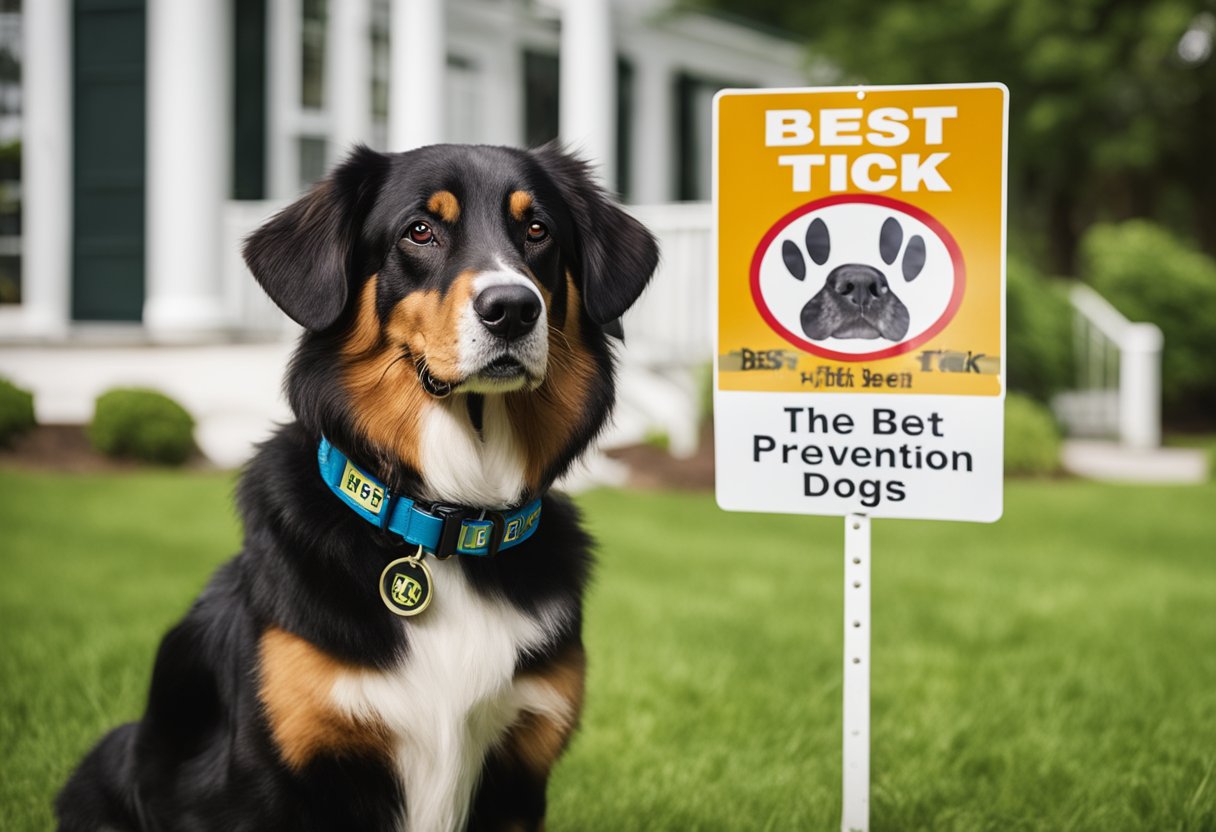Best Tick Prevention for Dogs: How to Keep Your Canine Companion Safe
Ticks can be a major problem for dogs, especially during the warmer months. These pesky parasites can transmit a variety of diseases, including Lyme disease, Rocky Mountain spotted fever, and ehrlichiosis. That’s why it’s important to take steps to prevent ticks from biting your dog in the first place. In this article, we’ll explore some of the best tick prevention methods for dogs.

Understanding Tick Prevention in Dogs There are several ways to prevent ticks from biting your dog. One of the most effective is to use a tick preventative medication. These medications come in a variety of forms, including topical treatments, oral medications, and collars. They work by killing ticks on contact or by preventing them from attaching to your dog in the first place.
Choosing the Right Tick Prevention When it comes to choosing a tick preventative medication for your dog, there are several factors to consider. These include your dog’s age, weight, and overall health, as well as your location and the time of year. It’s also important to choose a medication that is safe and effective. In this article, we’ll take a closer look at some of the most popular tick prevention products on the market, and help you choose the one that’s right for your dog.
Key Takeaways
- Ticks can transmit a variety of diseases to dogs, making tick prevention an important part of your dog’s healthcare routine.
- Tick preventative medications come in a variety of forms, including topical treatments, oral medications, and collars.
- When choosing a tick preventative medication for your dog, it’s important to consider your dog’s age, weight, and overall health, as well as your location and the time of year.
Understanding Tick Prevention in Dogs

Ticks are external parasites that can cause serious health problems in dogs. They are known to transmit diseases such as Lyme disease, Rocky Mountain spotted fever, and Ehrlichiosis. Therefore, it is important to take preventative measures to protect your dog from ticks.
Types of Tick Prevention Methods
There are several types of tick prevention methods available for dogs. These include:
- Topical Solutions: These are liquid solutions that are applied to the dog’s skin. They kill and repel ticks for a certain period of time. Examples include Frontline Plus and Advantix.
- Oral Medications: These are pills that are given to dogs. They work by killing ticks when they attach to the dog’s skin. Examples include Bravecto and Nexgard.
- Tick Collars: These are worn around the dog’s neck and release chemicals that kill ticks. Examples include Seresto and Preventic.
- Tick Sprays: These are sprays that are applied to the dog’s coat. They repel ticks and prevent them from attaching to the dog’s skin. Examples include Vet’s Best and Wondercide.
How Tick Prevention Works
Tick prevention methods work by either killing ticks or repelling them. Topical solutions, oral medications, and tick collars work by killing ticks when they come into contact with the dog’s skin or fur. Tick sprays work by repelling ticks and preventing them from attaching to the dog’s skin.
It is important to note that tick prevention methods are not 100% effective. Therefore, it is still important to check your dog for ticks regularly, especially after spending time outdoors in areas where ticks are common. If you do find a tick on your dog, it is important to remove it as soon as possible to reduce the risk of disease transmission.
In conclusion, there are several types of tick prevention methods available for dogs. It is important to choose a method that works best for your dog and to use it consistently to protect your dog from ticks.
Choosing the Right Tick Prevention

Ticks can be a serious threat to your dog’s health, and prevention is key to keeping them safe. But with so many options available, it can be difficult to choose the right tick prevention for your dog. Here are some factors to consider when making your decision.
Factors to Consider
- Your dog’s age, weight, and overall health: Some tick prevention medications may not be suitable for puppies, senior dogs, or dogs with certain health conditions. Always consult with your veterinarian before starting any tick prevention regimen.
- Your dog’s lifestyle: Does your dog spend a lot of time outdoors in wooded or grassy areas? Do you live in an area with a high tick population? These factors can help determine how often you need to administer tick prevention medication.
- Your personal preferences: Are you more comfortable using topical treatments or oral medications? Do you prefer natural alternatives? Consider your own preferences when choosing a tick prevention method.
Topical Treatments vs. Oral Medications
Topical treatments are applied directly to your dog’s skin, usually between the shoulder blades. They work by spreading over your dog’s body and killing ticks on contact. Oral medications, on the other hand, are ingested by your dog and work by killing ticks from the inside out.
Both topical treatments and oral medications can be effective at preventing ticks, but there are some differences to consider. Topical treatments may be more convenient for some dog owners, as they only need to be applied once a month. However, they can be messy and may not be suitable for dogs with sensitive skin. Oral medications may be a better choice for dogs with skin sensitivities, but they need to be administered more frequently.
Natural Alternatives and Their Efficacy
If you prefer natural alternatives, there are some options available for tick prevention. Some natural remedies include essential oils, apple cider vinegar, and garlic. However, it’s important to note that natural remedies have not been extensively studied for their effectiveness in tick prevention. Some may be harmful to your dog if ingested or applied incorrectly. Always consult with your veterinarian before using any natural remedies for tick prevention.
In conclusion, choosing the right tick prevention for your dog requires careful consideration of your dog’s age, weight, overall health, lifestyle, and your personal preferences. Both topical treatments and oral medications can be effective, but it’s important to choose a method that works best for you and your dog. If you’re considering natural alternatives, be sure to consult with your veterinarian first.
Resources

When it comes to protecting your furry friend from ticks, there are a variety of resources available to help you make informed decisions. Here are a few resources that can help you choose the best tick prevention for your dog:
- Your veterinarian: Your veterinarian is your best resource for information on tick prevention. They can recommend the best products for your dog based on their individual needs and health history. They can also provide guidance on how to properly apply the product and answer any questions you may have.
- The American Kennel Club: The American Kennel Club is a great resource for information on all aspects of dog care, including tick prevention. They offer a comprehensive guide on the best flea and tick prevention products for dogs, along with tips for preventing tick-borne diseases.
- The Centers for Disease Control and Prevention (CDC): The CDC provides information on tick-borne diseases and how to prevent them. They offer tips for avoiding ticks, removing ticks, and protecting your pets from ticks. They also provide information on the signs and symptoms of tick-borne diseases and when to seek medical attention.
- Product reviews and comparisons: There are many websites that offer reviews and comparisons of tick prevention products. However, it is important to be cautious when using these resources, as some may be biased or unreliable. Look for websites that are reputable and provide objective, evidence-based information.
- Other pet owners: Talking to other pet owners can also be a valuable resource. They can share their experiences with different tick prevention products and offer advice on what has worked best for their dogs.
Remember, the best way to protect your dog from ticks is to use a combination of prevention methods, including regular tick checks, tick repellent products, and avoiding tick-infested areas. Consult with your veterinarian and use reputable resources to make informed decisions about the best tick prevention for your furry friend.
Conclusion

Protecting your furry friend from ticks is crucial to their health and wellbeing. There are many options available for tick prevention, including oral medications, topical treatments, and collars. It’s important to choose the method that works best for you and your dog’s lifestyle.
When selecting a tick prevention method, consider the effectiveness, safety, and ease of use. Some products require monthly applications, while others last up to three months. Some products may also have potential side effects, so it’s important to talk to your veterinarian about what option is best for your dog.
It’s also important to note that tick prevention is just one part of keeping your dog healthy. Regular check-ups, vaccinations, and a healthy diet are also important factors in keeping your dog happy and healthy.
By taking the necessary steps to prevent ticks, you can ensure that your dog stays protected and healthy. Remember to always consult with your veterinarian before starting any new medication or treatment plan for your furry friend.
Frequently Asked Questions

What is the most effective flea and tick prevention for dogs?
The most effective flea and tick prevention for dogs is a product that contains an active ingredient that kills ticks on contact. Some of the most commonly used and effective ingredients include fipronil, permethrin, and fluralaner. Consult with your veterinarian to determine which product is best for your dog based on their age, weight, and overall health.
Which dog flea and tick control is considered the best?
The best flea and tick control for dogs will depend on a variety of factors, including your dog’s age, weight, and overall health. Some of the most popular flea and tick control products include topical solutions, oral medications, collars, and sprays. Again, it is best to consult with your veterinarian to determine which product is best for your dog.
How can I prevent ticks on my dog without a vet prescription?
There are several ways to prevent ticks on your dog without a vet prescription. One of the most effective ways is to regularly groom your dog and check for ticks. Additionally, you can use natural remedies such as essential oils, apple cider vinegar, and garlic. However, it is important to note that natural remedies may not be as effective as prescription medications and should be used with caution.
What are the best home remedies for preventing ticks on dogs?
Some of the best home remedies for preventing ticks on dogs include essential oils, apple cider vinegar, and garlic. Essential oils such as lavender, peppermint, and eucalyptus can be diluted and applied to your dog’s collar or bedding. Apple cider vinegar can be added to your dog’s water or sprayed directly on their coat. Garlic can also be added to your dog’s food. However, it is important to note that natural remedies may not be as effective as prescription medications and should be used with caution.
Does tick medicine effectively kill ticks on dogs?
Yes, tick medicine effectively kills ticks on dogs. Tick medicine contains an active ingredient that kills ticks on contact. Some of the most commonly used and effective ingredients include fipronil, permethrin, and fluralaner. It is important to follow the instructions on the product label carefully and consult with your veterinarian to determine which product is best for your dog.
How do you keep ticks off dogs using natural methods?
There are several natural methods for keeping ticks off dogs. One of the most effective ways is to regularly groom your dog and check for ticks. Additionally, you can use natural remedies such as essential oils, apple cider vinegar, and garlic. Essential oils such as lavender, peppermint, and eucalyptus can be diluted and applied to your dog’s collar or bedding. Apple cider vinegar can be added to your dog’s water or sprayed directly on their coat. Garlic can also be added to your dog’s food. However, it is important to note that natural remedies may not be as effective as prescription medications and should be used with caution.
